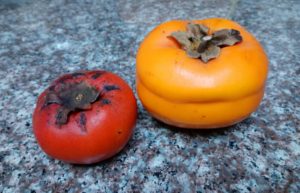I am a recent convert to the delicious taste of persimmon. We have a tree at Extension’s Brazoria Environmental Education Station (BEES) orchard in Angleton that produced fruit with a sweet and almost jelly-like flesh that was outstanding in taste and texture. I invite you to consider persimmon for your home orchard. While native varieties such as the American persimmon (Diospyros virginiana) can be cultivated, varieties of Japanese persimmon (Diospyros kaki), sometimes called Oriental persimmon or Kaki, are often used in space constricted urban orchards. These fruiting members of the hardwood ebony plant family are relatively small trees that can be used both as an ornamental landscape feature as well as a food source. American persimmon can reach up to 40-feet, while Japanese persimmon varieties can be kept compact at 15-feet. They are deciduous, with dark green leaves turning brilliant colors of orange-red to gold in the fall. The majority produces medium tomato-sized fruit that are flatter than round, featuring vivid colors from cream-orange to deep red that complement bare branches in early winter.
I am interested in the history of global plant distribution. Knowing where plants originated can help broaden our cultural understanding of one another. According to a plant profile from the Missouri Botanical Garden, Japanese persimmon is native to a broad range of the Asian continent: from India and Burma to China and Korea and is widely cultivated in Japan. Kaki were brought to the U.S. from Japan in 1856 by Commodore Perry, more than likely attributed to the Perry Expedition and establishment of global trade with Japan. Commercial production increased in the 1930’s in California and southeast U.S., and today the majority of fruit sold in broad markets across the states are from California orchards.
Fortunately, persimmon can grow in a variety of soil types and success is dependant on the rootstock. Rootstock is defined as one variety or species of rooted tree that is top-grafted with another species. For our eco-region, American persimmon is used as a rootstock for Japanese persimmon as it is more adaptable to regional soil profiles and resistant to soil-borne pathogens. Bare-root trees can be planted in January and February. Remove half of the top of the tree to a single trunk; pruning in this fashion forces growth to develop a framework of branches based off a central leader. Containerized trees should be planted in early spring, from late February to early April and pruned to shape. Multiple plantings should be spaced 20-feet apart. Fruit develops on branches growing in the current season. As with most fruiting trees, you may begin to see fruit production within the first 3 years after establishment. Most Japanese persimmons produce seedless fruit, with exception of variety ‘Eureka’. Some varieties, like ‘Fuyu’, are self-fruitful. Fuyu can be used as a pollinator for all varieties grown in our area.
While persimmons are valued for their sweet taste and pleasant texture, varieties are listed as either astringent or non-astringent. Most persimmons are astringent and must be fully ripe and soft prior to eating to reduce an unpleasant pucker from your palate. Variety ‘Fuyu’ and ‘Izu’ are two non-astringent, medium-sized and self-fruitful varieties that perform well in our area. Fuyu fruit is flattened in appearance with deep orange-colored rind; keep in mind that Fuyu can be affected by sustained seasonal freezing weather. Izu looks more rounded with lighter orange-yellow tones and is more cold hardy than Fuyu. Variety ‘Tamopan’ is an astringent variety that produces very large and flattened orange-colored fruit. Tamopan has a distinctive ring constriction near the middle of the fruit, providing a ‘wow’ factor for the effort of growing. This variety has a vigorous and upright growth habit, so my advice is to plant it as a single specimen if in the home landscape.
Japanese persimmon can make a great addition to your home landscape, a fruiting tree that can be kept pruned to height, has great seasonal value with vibrant leaves in the fall and colorful fruits that can be left to ripen on the tree. If you want to find out more about fruiting trees for your home, I am hosting urban orchard series seasonally and throughout the year. Have a great day and I’ll see you in the garden.

